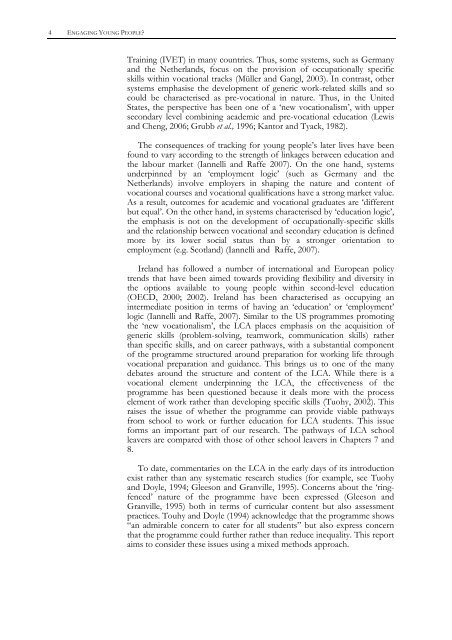Student Experiences of the Leaving Certificate Applied Programme
Student Experiences of the Leaving Certificate Applied Programme
Student Experiences of the Leaving Certificate Applied Programme
Create successful ePaper yourself
Turn your PDF publications into a flip-book with our unique Google optimized e-Paper software.
4 ENGAGING YOUNG PEOPLE?Training (IVET) in many countries. Thus, some systems, such as Germanyand <strong>the</strong> Ne<strong>the</strong>rlands, focus on <strong>the</strong> provision <strong>of</strong> occupationally specificskills within vocational tracks (Müller and Gangl, 2003). In contrast, o<strong>the</strong>rsystems emphasise <strong>the</strong> development <strong>of</strong> generic work-related skills and socould be characterised as pre-vocational in nature. Thus, in <strong>the</strong> UnitedStates, <strong>the</strong> perspective has been one <strong>of</strong> a ‘new vocationalism’, with uppersecondary level combining academic and pre-vocational education (Lewisand Cheng, 2006; Grubb et al., 1996; Kantor and Tyack, 1982).The consequences <strong>of</strong> tracking for young people’s later lives have beenfound to vary according to <strong>the</strong> strength <strong>of</strong> linkages between education and<strong>the</strong> labour market (Iannelli and Raffe 2007). On <strong>the</strong> one hand, systemsunderpinned by an ‘employment logic’ (such as Germany and <strong>the</strong>Ne<strong>the</strong>rlands) involve employers in shaping <strong>the</strong> nature and content <strong>of</strong>vocational courses and vocational qualifications have a strong market value.As a result, outcomes for academic and vocational graduates are ‘differentbut equal’. On <strong>the</strong> o<strong>the</strong>r hand, in systems characterised by ‘education logic’,<strong>the</strong> emphasis is not on <strong>the</strong> development <strong>of</strong> occupationally-specific skillsand <strong>the</strong> relationship between vocational and secondary education is definedmore by its lower social status than by a stronger orientation toemployment (e.g. Scotland) (Iannelli and Raffe, 2007).Ireland has followed a number <strong>of</strong> international and European policytrends that have been aimed towards providing flexibility and diversity in<strong>the</strong> options available to young people within second-level education(OECD, 2000; 2002). Ireland has been characterised as occupying anintermediate position in terms <strong>of</strong> having an ‘education’ or ‘employment’logic (Iannelli and Raffe, 2007). Similar to <strong>the</strong> US programmes promoting<strong>the</strong> ‘new vocationalism’, <strong>the</strong> LCA places emphasis on <strong>the</strong> acquisition <strong>of</strong>generic skills (problem-solving, teamwork, communication skills) ra<strong>the</strong>rthan specific skills, and on career pathways, with a substantial component<strong>of</strong> <strong>the</strong> programme structured around preparation for working life throughvocational preparation and guidance. This brings us to one <strong>of</strong> <strong>the</strong> manydebates around <strong>the</strong> structure and content <strong>of</strong> <strong>the</strong> LCA. While <strong>the</strong>re is avocational element underpinning <strong>the</strong> LCA, <strong>the</strong> effectiveness <strong>of</strong> <strong>the</strong>programme has been questioned because it deals more with <strong>the</strong> processelement <strong>of</strong> work ra<strong>the</strong>r than developing specific skills (Tuohy, 2002). Thisraises <strong>the</strong> issue <strong>of</strong> whe<strong>the</strong>r <strong>the</strong> programme can provide viable pathwaysfrom school to work or fur<strong>the</strong>r education for LCA students. This issueforms an important part <strong>of</strong> our research. The pathways <strong>of</strong> LCA schoolleavers are compared with those <strong>of</strong> o<strong>the</strong>r school leavers in Chapters 7 and8.To date, commentaries on <strong>the</strong> LCA in <strong>the</strong> early days <strong>of</strong> its introductionexist ra<strong>the</strong>r than any systematic research studies (for example, see Tuohyand Doyle, 1994; Gleeson and Granville, 1995). Concerns about <strong>the</strong> ‘ringfenced’nature <strong>of</strong> <strong>the</strong> programme have been expressed (Gleeson andGranville, 1995) both in terms <strong>of</strong> curricular content but also assessmentpractices. Touhy and Doyle (1994) acknowledge that <strong>the</strong> programme shows“an admirable concern to cater for all students” but also express concernthat <strong>the</strong> programme could fur<strong>the</strong>r ra<strong>the</strong>r than reduce inequality. This reportaims to consider <strong>the</strong>se issues using a mixed methods approach.

















